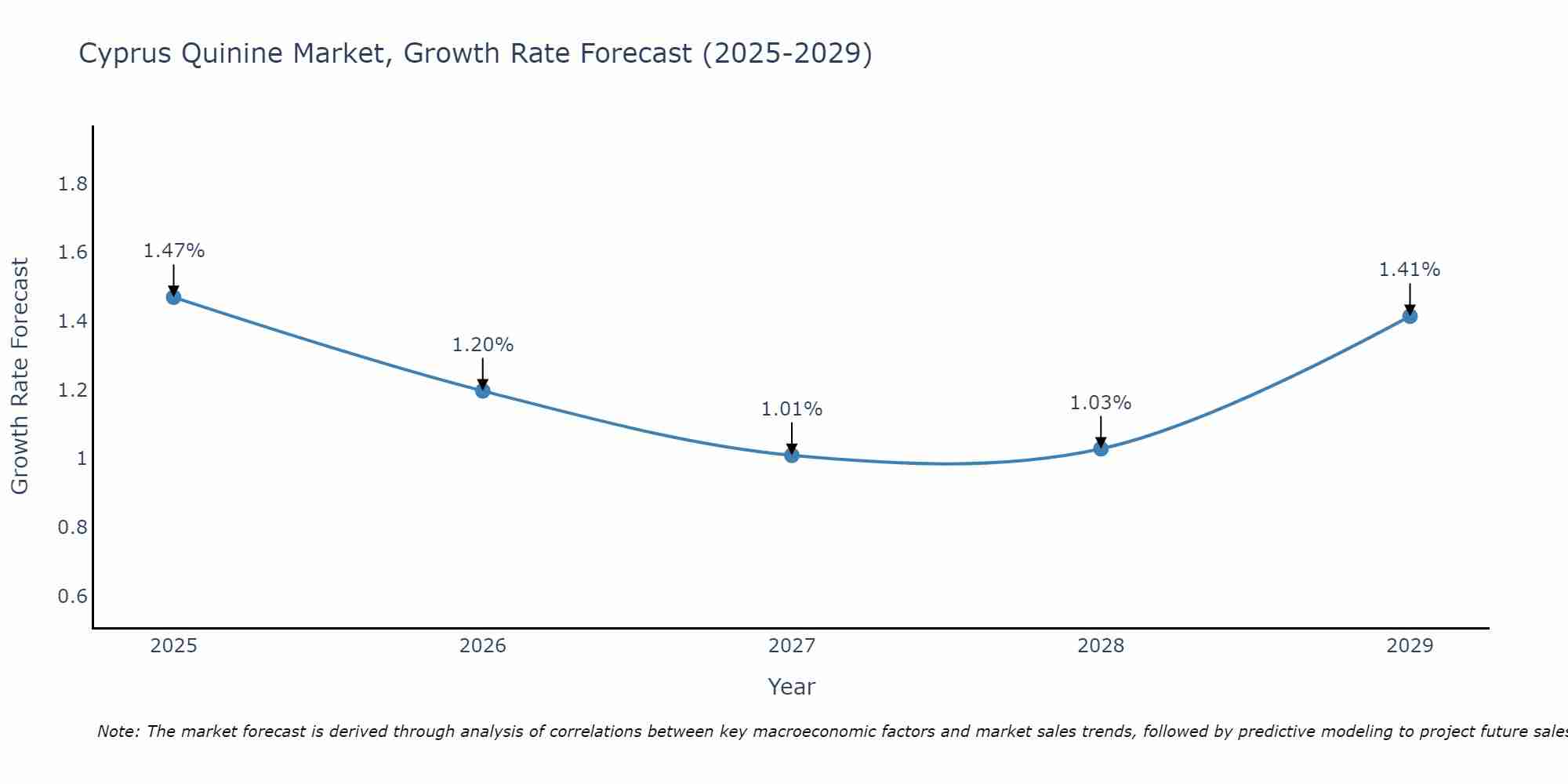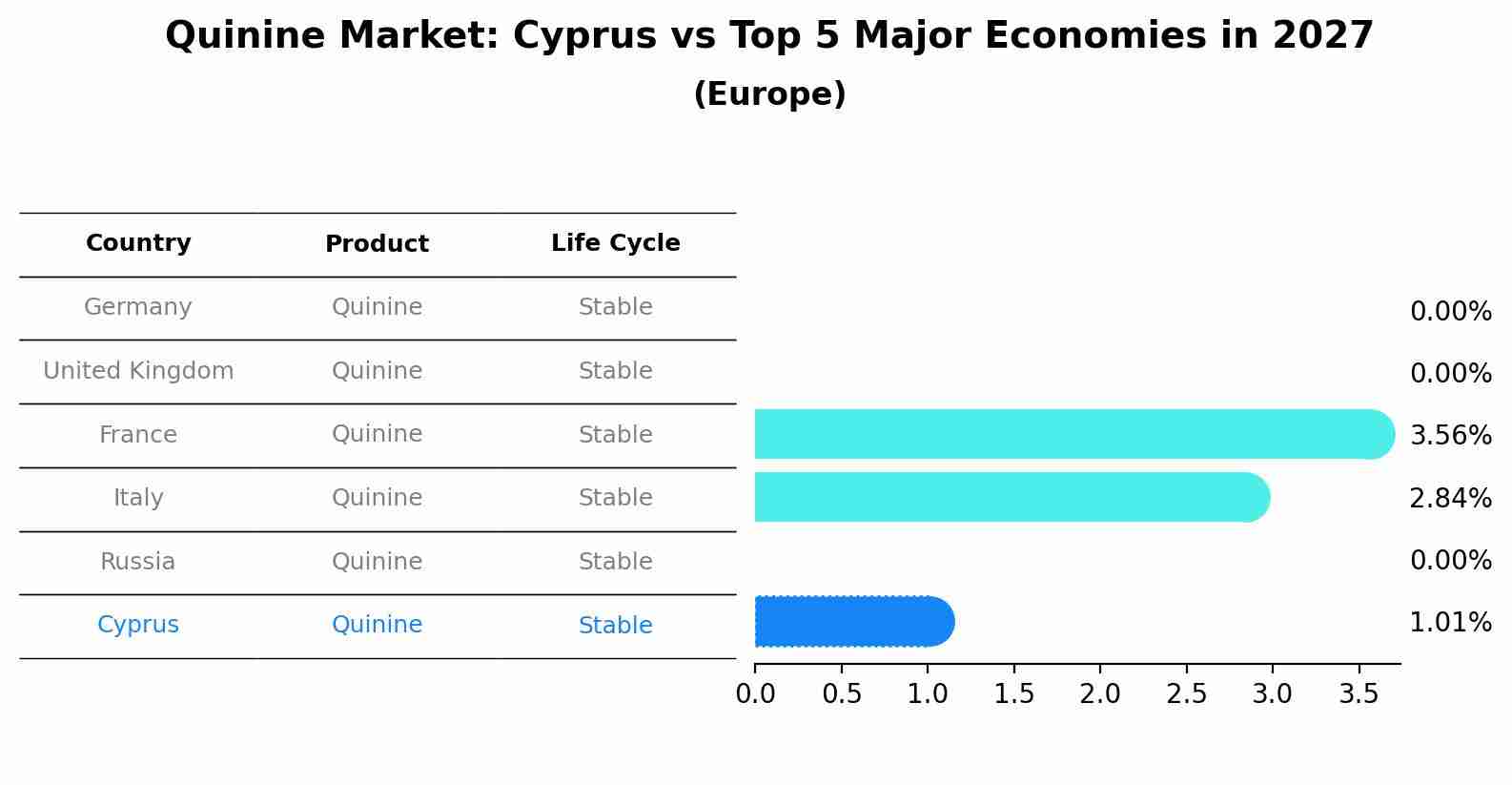Cyprus Quinine Market (2025-2031) | Segmentation, Growth, Analysis, Value, Companies, Trends, Outlook, Forecast, Share, Industry, Size & Revenue
| Product Code: ETC5312443 | Publication Date: Nov 2023 | Updated Date: Apr 2025 | Product Type: Market Research Report | |
| Publisher: 6Wresearch | Author: Bhawna Singh | No. of Pages: 60 | No. of Figures: 30 | No. of Tables: 5 |
Cyprus Quinine Market Size Growth Rate
The Cyprus Quinine Market is projected to witness mixed growth rate patterns during 2025 to 2029. Beginning strongly at 1.47% in 2025, growth softens to 1.41% in 2029.

Quinine Market: Cyprus vs Top 5 Major Economies in 2027 (Europe)
The Quinine market in Cyprus is projected to grow at a stable growth rate of 1.01% by 2027, highlighting the country's increasing focus on advanced technologies within the Europe region, where Germany holds the dominant position, followed closely by United Kingdom, France, Italy and Russia, shaping overall regional demand.

Cyprus Quinine Market Overview
The quinine market in Cyprus is primarily driven by the demand for antimalarial drugs and dietary supplements. Quinine, derived from the bark of the cinchona tree, is recognized for its medicinal properties, especially in treating malaria. With the ongoing global health challenges, the need for effective treatments remains critical. The market may also benefit from the growing interest in natural remedies and herbal supplements. However, regulatory challenges and competition from synthetic alternatives may pose constraints to market growth, necessitating ongoing research and development.
Drivers of the market
The quinine market in Cyprus is driven by its established use in treating malaria and its growing applications in the pharmaceutical industry. The increasing prevalence of malaria and the need for effective treatment options are propelling the demand for quinine-based medications. Moreover, quinine`s role as a flavoring agent in beverages, particularly tonic water, contributes to its market growth. The rising awareness of herbal and natural remedies has also led to a resurgence in the use of quinine in traditional medicine, further driving demand. Additionally, ongoing research and development activities aimed at enhancing quinine`s efficacy and reducing side effects are expected to bolster market growth in the coming years.
Challenges of the market
The quinine market in Cyprus experiences challenges primarily due to the limited local demand, as quinine is mostly used in pharmaceutical applications and beverages. The small pharmaceutical manufacturing base in the country restricts the scope of local production. Moreover, fluctuations in the global supply of quinine, driven by changes in demand for antimalarial drugs and tonic water, create price volatility. Stringent regulations on pharmaceutical ingredients and the high cost of compliance further complicate the market landscape.
Government Policy of the market
In Cyprus, the market for quinine is primarily influenced by regulations concerning the pharmaceutical industry and import-export policies. The government regulates the use of quinine in medicinal products and beverages, ensuring compliance with European standards for safety and efficacy. Additionally, policies related to the import of raw materials for pharmaceutical production impact the availability of quinine for both medicinal and beverage applications. Any changes in tariffs or trade agreements can directly affect market dynamics.
Key Highlights of the Report:
- Cyprus Quinine Market Outlook
- Market Size of Cyprus Quinine Market, 2024
- Forecast of Cyprus Quinine Market, 2031
- Historical Data and Forecast of Cyprus Quinine Revenues & Volume for the Period 2021-2031
- Cyprus Quinine Market Trend Evolution
- Cyprus Quinine Market Drivers and Challenges
- Cyprus Quinine Price Trends
- Cyprus Quinine Porter`s Five Forces
- Cyprus Quinine Industry Life Cycle
- Historical Data and Forecast of Cyprus Quinine Market Revenues & Volume By Mode of Administration for the Period 2021-2031
- Historical Data and Forecast of Cyprus Quinine Market Revenues & Volume By Oral Administration for the Period 2021-2031
- Historical Data and Forecast of Cyprus Quinine Market Revenues & Volume By Intravenous Administration for the Period 2021-2031
- Historical Data and Forecast of Cyprus Quinine Market Revenues & Volume By Intramuscular Administration for the Period 2021-2031
- Historical Data and Forecast of Cyprus Quinine Market Revenues & Volume By Others for the Period 2021-2031
- Historical Data and Forecast of Cyprus Quinine Market Revenues & Volume By Application for the Period 2021-2031
- Historical Data and Forecast of Cyprus Quinine Market Revenues & Volume By Antimalarial for the Period 2021-2031
- Historical Data and Forecast of Cyprus Quinine Market Revenues & Volume By Antipyretic for the Period 2021-2031
- Historical Data and Forecast of Cyprus Quinine Market Revenues & Volume By Others for the Period 2021-2031
- Historical Data and Forecast of Cyprus Quinine Market Revenues & Volume By End-user for the Period 2021-2031
- Historical Data and Forecast of Cyprus Quinine Market Revenues & Volume By Hospitals for the Period 2021-2031
- Historical Data and Forecast of Cyprus Quinine Market Revenues & Volume By Clinics for the Period 2021-2031
- Historical Data and Forecast of Cyprus Quinine Market Revenues & Volume By Ambulatory Surgical Centers for the Period 2021-2031
- Historical Data and Forecast of Cyprus Quinine Market Revenues & Volume By Others for the Period 2021-2031
- Cyprus Quinine Import Export Trade Statistics
- Market Opportunity Assessment By Mode of Administration
- Market Opportunity Assessment By Application
- Market Opportunity Assessment By End-user
- Cyprus Quinine Top Companies Market Share
- Cyprus Quinine Competitive Benchmarking By Technical and Operational Parameters
- Cyprus Quinine Company Profiles
- Cyprus Quinine Key Strategic Recommendations
Frequently Asked Questions About the Market Study (FAQs):
1 Executive Summary |
2 Introduction |
2.1 Key Highlights of the Report |
2.2 Report Description |
2.3 Market Scope & Segmentation |
2.4 Research Methodology |
2.5 Assumptions |
3 Cyprus Quinine Market Overview |
3.1 Cyprus Country Macro Economic Indicators |
3.2 Cyprus Quinine Market Revenues & Volume, 2021 & 2031F |
3.3 Cyprus Quinine Market - Industry Life Cycle |
3.4 Cyprus Quinine Market - Porter's Five Forces |
3.5 Cyprus Quinine Market Revenues & Volume Share, By Mode of Administration, 2021 & 2031F |
3.6 Cyprus Quinine Market Revenues & Volume Share, By Application, 2021 & 2031F |
3.7 Cyprus Quinine Market Revenues & Volume Share, By End-user, 2021 & 2031F |
4 Cyprus Quinine Market Dynamics |
4.1 Impact Analysis |
4.2 Market Drivers |
4.3 Market Restraints |
5 Cyprus Quinine Market Trends |
6 Cyprus Quinine Market Segmentations |
6.1 Cyprus Quinine Market, By Mode of Administration |
6.1.1 Overview and Analysis |
6.1.2 Cyprus Quinine Market Revenues & Volume, By Oral Administration, 2021-2031F |
6.1.3 Cyprus Quinine Market Revenues & Volume, By Intravenous Administration, 2021-2031F |
6.1.4 Cyprus Quinine Market Revenues & Volume, By Intramuscular Administration, 2021-2031F |
6.1.5 Cyprus Quinine Market Revenues & Volume, By Others, 2021-2031F |
6.2 Cyprus Quinine Market, By Application |
6.2.1 Overview and Analysis |
6.2.2 Cyprus Quinine Market Revenues & Volume, By Antimalarial, 2021-2031F |
6.2.3 Cyprus Quinine Market Revenues & Volume, By Antipyretic, 2021-2031F |
6.2.4 Cyprus Quinine Market Revenues & Volume, By Others, 2021-2031F |
6.3 Cyprus Quinine Market, By End-user |
6.3.1 Overview and Analysis |
6.3.2 Cyprus Quinine Market Revenues & Volume, By Hospitals, 2021-2031F |
6.3.3 Cyprus Quinine Market Revenues & Volume, By Clinics, 2021-2031F |
6.3.4 Cyprus Quinine Market Revenues & Volume, By Ambulatory Surgical Centers, 2021-2031F |
6.3.5 Cyprus Quinine Market Revenues & Volume, By Others, 2021-2031F |
7 Cyprus Quinine Market Import-Export Trade Statistics |
7.1 Cyprus Quinine Market Export to Major Countries |
7.2 Cyprus Quinine Market Imports from Major Countries |
8 Cyprus Quinine Market Key Performance Indicators |
9 Cyprus Quinine Market - Opportunity Assessment |
9.1 Cyprus Quinine Market Opportunity Assessment, By Mode of Administration, 2021 & 2031F |
9.2 Cyprus Quinine Market Opportunity Assessment, By Application, 2021 & 2031F |
9.3 Cyprus Quinine Market Opportunity Assessment, By End-user, 2021 & 2031F |
10 Cyprus Quinine Market - Competitive Landscape |
10.1 Cyprus Quinine Market Revenue Share, By Companies, 2024 |
10.2 Cyprus Quinine Market Competitive Benchmarking, By Operating and Technical Parameters |
11 Company Profiles |
12 Recommendations | 13 Disclaimer |
- Single User License$ 1,995
- Department License$ 2,400
- Site License$ 3,120
- Global License$ 3,795
Search
Thought Leadership and Analyst Meet
Our Clients
Related Reports
- Afghanistan Apparel Market (2026-2032) | Growth, Outlook, Industry, Segmentation, Forecast, Size, Companies, Trends, Value, Share, Analysis & Revenue
- Canada Oil and Gas Market (2026-2032) | Share, Segmentation, Value, Industry, Trends, Forecast, Analysis, Size & Revenue, Growth, Competitive Landscape, Outlook, Companies
- Germany Breakfast Food Market (2026-2032) | Industry, Share, Growth, Size, Companies, Value, Analysis, Revenue, Trends, Forecast & Outlook
- Australia Briquette Market (2025-2031) | Growth, Size, Revenue, Forecast, Analysis, Trends, Value, Share, Industry & Companies
- Vietnam System Integrator Market (2025-2031) | Size, Companies, Analysis, Industry, Value, Forecast, Growth, Trends, Revenue & Share
- ASEAN and Thailand Brain Health Supplements Market (2025-2031) | Strategy, Consumer Insights, Analysis, Investment Trends, Opportunities, Growth, Size, Share, Industry, Revenue, Segments, Value, Segmentation, Supply, Forecast, Restraints, Outlook, Competition, Drivers, Trends, Demand, Pricing Analysis, Competitive, Strategic Insights, Companies, Challenges
- ASEAN Bearings Market (2025-2031) | Strategy, Consumer Insights, Analysis, Investment Trends, Opportunities, Growth, Size, Share, Industry, Revenue, Segments, Value, Segmentation, Supply, Forecast, Restraints, Outlook, Competition, Drivers, Trends, Demand, Pricing Analysis, Competitive, Strategic Insights, Companies, Challenges
- Europe Flooring Market (2025-2031) | Outlook, Share, Industry, Trends, Forecast, Companies, Revenue, Size, Analysis, Growth & Value
- Saudi Arabia Manlift Market (2025-2031) | Outlook, Size, Growth, Trends, Companies, Industry, Revenue, Value, Share, Forecast & Analysis
- Uganda Excavator, Crane, and Wheel Loaders Market (2025-2031) | Strategy, Consumer Insights, Analysis, Investment Trends, Opportunities, Growth, Size, Share, Industry, Revenue, Segments, Value, Segmentation, Supply, Forecast, Restraints, Outlook, Competition, Drivers, Trends, Demand, Pricing Analysis, Competitive, Strategic Insights, Companies, Challenges
Industry Events and Analyst Meet
Whitepaper
- Middle East & Africa Commercial Security Market Click here to view more.
- Middle East & Africa Fire Safety Systems & Equipment Market Click here to view more.
- GCC Drone Market Click here to view more.
- Middle East Lighting Fixture Market Click here to view more.
- GCC Physical & Perimeter Security Market Click here to view more.
6WResearch In News
- Doha a strategic location for EV manufacturing hub: IPA Qatar
- Demand for luxury TVs surging in the GCC, says Samsung
- Empowering Growth: The Thriving Journey of Bangladesh’s Cable Industry
- Demand for luxury TVs surging in the GCC, says Samsung
- Video call with a traditional healer? Once unthinkable, it’s now common in South Africa
- Intelligent Buildings To Smooth GCC’s Path To Net Zero


















